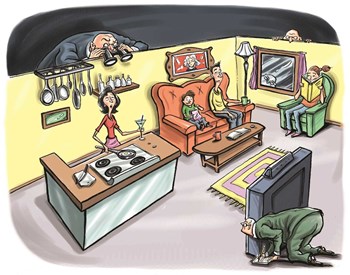
From time immemorial, the home has been synonymous with warmth, comfort and, most importantly, safety. The boards and managers who oversee community associations are aiming to preserve this image by ensuring that safety is their top priority, and that residents should harbor no fear in regard to their well-being, or the well-being of their families and property.
Of course, there must remain a line between a resident's safety and an intrusion upon a resident's privacy, of which a board or management must constantly be aware. With the broad range of technological options available today that purport to monitor and secure properties, their continual evolution is bound to stir up questions regarding privacy. But, for many communities, those issues are outweighed by a desire to have as many safeguards in place as possible.
A Watchful Eye
The ways in which community associations and HOAs approach security have changed over the years, moving from a reliance on security guards and regular patrols to more access control and visual monitoring. The days wherein a manager would hire a private investigator to sit outside and watch a building's entrance for riff-raff are long gone. And while concierges and security guards are still prevalent in many communities, cameras do the heavy lifting when it comes to security monitoring.
The growth in the popularity of cameras can be heavily attributed to the increase of affordable technology in the marketplace, as well as their expanding functionality. "Cameras are on the rise, and, on quite a few occasions, I've been contacted by law enforcement, asking to view footage," says Jay Cohen, director of operations at A. Michael Tyler Realty Corp. in New York City. "Oftentimes, they're quite successful in helping to apprehend a criminal because they're able to capture a very clear image of the perpetrator." Crimes prevented by providing police access to clear camera footage have included thefts, assaults, vandalism, and worse.
Alan Geisenheimer, president of Geisenheimer Insurance Agency in Fair Lawn, New Jersey, concurs and expands on Cohen's observations: "Buyers are seeking security in their homes, and selling points include in-unit alarms, closed circuit TV and gated communities."
And the signs indicating that an area is being monitored can be a deterrent on their own. Dean Roberts, an attorney with Norris McLaughlin & Marcus, P.A., which has offices in New Jersey, New York City and Pennsylvania, notes that "while most people [who have nothing with which to be concerned] quickly forget that they are being taped, people inclined to do damage or otherwise misbehave in common areas are much more aware that they're being watched, and thereby refrain from doing [anything nefarious] in videotaped areas."
The criminal element isn't the only thing that cameras can help illuminate. As Michael Manzi, an attorney with the law firm of Balber Pickard Maldonado & Van Der Tuin in New York City notes, "cameras can provide evidence in connection with trip-and-falls and other tort cases."
Edward J. Mackoul, president of insurance agency Mackoul Risk Solutions in New York and New Jersey, concurs. "There have been plenty of instances in which a claimant says that they fell because of negligence on the part of the property owner, but the cameras proved that there was no incident," he says.
Geisenheimer relates a specific instance of this: "Recently, a super reported that a woman limped up to him, claiming that she had fallen on the front step of the building. They viewed the tape recording, and saw the woman and her husband leave the building, only for the woman to come running back moments later. She then left again, head down, viewing her cell phone without looking where she was going, and fell. The footage here should go a long way toward avoiding a lawsuit."
Many cameras within residential properties are equipped with motion sensors, thereby allowing them to capture all of the above without wasting limited footage filming a dormant hallway. When an incident (or an injury) is primed to take place, the camera will be triggered to capture the entirety of the altercation/situation more likely than not.
Having these events on record is extremely useful from an insurance standpoint. If an incident is caught online, as Cohen explains, the camera footage can be presented directly to the insurance carrier, and, in the case of a personal injury claim, should it be proven fraudulent, that can benefit insurance premiums for everyone involved.
Wave of the Future
While grainy, near-indecipherable camera footage used to be the norm in residential communities, modern cameras have made leaps and bounds from their older-fashioned counterparts. And they're more affordable to boot.
"The sophisticated high-definition cameras that are now available allow people to make out faces much better than they could in previous decades," says Cohen. "What was once out of reach from a price-point perspective is now affordable for many properties. There are now low-lux, HD, full-color cameras that are much more affordable to associations, and many buildings have taken advantage."
In days gone by, cameras recorded surveillance footage onto video tape that could be later viewed via VCR. Then, the advent of DVD allowed interested parties to assess camera feeds online. But now, according to Cohen, "the software has advanced to the point where you can download the recordings to your smart phone and watch them immediately, so you no longer need to be in front of a computer system at all." This means that a manager could ostensibly view footage of an incident within seconds after it's reported, significantly minimizing response times for any outside parties (police, EMTs, etc.) that need to be contacted.
Whither the Doorman?
There was once a time wherein the friendly (or decidedly not-so) doorman was the first—or only—line of defense against anyone nefarious entering a private residence. Since the advent of security systems, the doorman's role has been downplayed, but, oftentimes, they still serve to keep residents safe and at ease.
"Just the presence of someone in a building can be a deterrent to anyone who may want to enter illegally, or go into a stairwell and lurk," says Cohen.
And while a security camera can monitor faces and activities, it's nowhere near as good with names and issues of intent as a man on the ground. A doorman's log can sometimes be the best source of information as to who specifically is entering and exiting a community.
Not all doormen are even on site. As Cohen explains, there are now "cyberdoorman" services that monitor lobbies live, 24 hours a day, seven days per week. These services can be modified to supplement an on-site doorman as well, taking over when he or she takes a break, or even leaves to have a cigarette or use the lavatory.
The doorman situation can cut both ways, however. "I have seen push-back from residents once a property that had been doorman-free puts one in place," says Manzi. "The occasional resident will have moved into that building precisely because there hadn't been a doorman. Some people don't want anyone knowing the specifics of their comings and goings, monitoring them, or knowing who visits their apartment."
While doormen maintain a prominent role in many residential communities, security guards are on the wane. As the role of a security guard is to act as the middleman on the property between residents and the police, their necessity has been reduced as cameras have become more prominent. "I believe that the price point for [security guards] is not affordable anymore for most associations, and that the camera is a more logical/affordable solution," says Cohen.
The Big Issues
The experts agree that cameras can be a deterrent for both crime and fraudulent legal action, but there are other issues that an association must take into account when installing a security system. The first among them is privacy: when does protecting residents' safety infringe on those residents' personal rights?
"Privacy is an important issue when it comes to videotaping, as people are often concerned with the basic fact that they are being watched," says Roberts. "But what's more important than the simple fact of being watched is who is actually watching the tapes. It is my standard recommendation to clients that a clear written policy regarding the videotapes be in place, outlining who can and cannot access them, and how the information can be released, if it can be at all. A board does not want to even allow the perception that they sit and watch surveillance footage of their neighbors."
Geisenheimer also notes that an association must keep recordings for over two years, in an effort to cover the statute of limitations on any lawsuits that may arise within a community.
Fortunately for residents wary of having their personal matters exposed, associations are limited to surveying only common areas, either via camera or security personnel. And residents themselves have the option to install their own security measures, including cameras, granted they undertake the same concerns for their neighbors' privacy.
"A unit owner or tenant-shareholder can install whatever security measures he/she wishes within his/her own space," says Manzi. "They may not, however, install equipment in common areas, or that, inadvertently or not, 'spy' on other units." This pertains mostly to cameras that may record what goes on through doors or windows.
There's also the issue of how democratic the process of installing a security system should be. In the instance cited by Manzi above, wherein residents opposed the hiring of a doorman/security guard en masse, the board polled the entire community, and they chose to continue on without any on-site personnel. However, this was only feasible due to the building's smaller size. As Manzi explains, "in a large community this type of open vote is not feasible. It really falls to the board to make the decisions, as long as they keep the tenant shareholders apprised as to what they're doing."
Despite the authority (and the burden) of security installation falling mainly on the board, treating all residents in good faith is in any association's best interests. "Given that the use of surveillance in common areas affects all members of an association, it is far better for a board to have an open discussion with community members," says Norris. "But let it be known: this is a political suggestion, and not a legal one. A board is fully within its power to implement a videotaping system without a shareholder vote." It's also imperative to take into account that, while common areas can be videotaped, audio is generally forbidden.
One way to assuage the potential worries of residents in regard to a security system is to explain the insurance benefits thereof. As Geisenheimer says, "it should be explained that any cameras and taping aim to deter false liability claims, which keep an association's insurance costs down, and, most importantly, the dues of the residents."
It's also important to note issues of liability in instances wherein security personnel or residents themselves take action during an apparent incident. Manpower within a property has diminished with the evolution and affordability of effective technology. Years ago, according to Cohen, tenants formed patrol units among themselves that would stake out lobbies and patrol a property, but that doesn't happen anymore. However board members should be aware that they may be held liable should a resident or owner get into an altercation on the property.
"Some general liability policies have exclusions in them for claims resulting from firearms or assault and battery," says Mackoul. Intent is generally excluded as well. If a unit owner or resident were to injure someone, have them arrested, defamed, etc., and it turned out to be unjustified, the association and individual could be sued."
An association can also be sued for not doing enough to keep a premises secure. "If you have a building with neither security system nor doorman, and at some point, there is crime within the building, an association may well be sued, with the complainant alleging that the board was aware of a rash of crimes in the area," says Manzi. "That association can be accused of refusing to install even minimal security measures, and the next thing they know, they'll be sued for negligence."
Safety First
There are clearly myriad variables to take into account when planning a security system for an association, from the personal to the financial to the legal. But one thing stands out above all else: the safety of the residents is paramount. Even in large properties where a wide vote over specifics is an impossibility, by promoting clear lines of communication and explaining exactly what security measures will be undertaken and why, a board can ensure that its residents feel safe and secure within their own walls.
Mike Odenthal is a staff writer for The Nevada Cooperator.






Leave a Comment